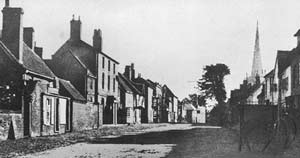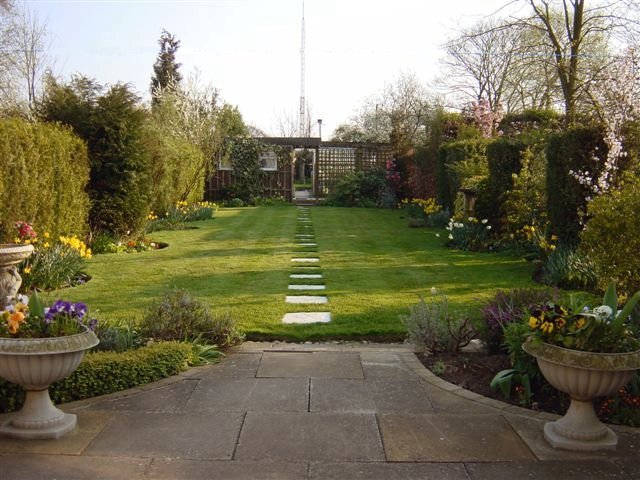The Borough Of Solihull.


Below to the right is Solihull high street in 1829. This was laid out as the Principal street when the new town was founded by the Limesi family about 800 years ago. I live in Ulleries Road Olton which mean's old Town.
A good deal over a thousand years ago, a man of Anglo-Saxon extraction arrived with a small band of hearth-followers in the north-western corner of the area which is today the Borough of Solihull. Possibly his name was Wulfhere. Needless to say, he was far from being the first person to set foot here. The ''Borough'' must have served at least as a hunting ground since remote prehistoric times.
Later, during the Celtic period (from 500 B.C.), a community of ''Ancient Britons'' had inhabited the fortified village at Berry Mound, Shirley, where vestiges of their earthwork can still be inspected.
We know little about the locality either in the Celtic or in the Roman period. However,despite the presence of Berry Mound, it seems unlikely that agricultural exploitation thus far had amounted to very much.
Like an American settler pushing west in more recent times, what Wulfhere found was predominately virgin territory.
In fact, most of the district was still covered by forest. Wherever the soil was clay, it was a thick deciduous forest of oak, ash, elm and bramble. Elsewhere, there were light sandy soils and here the tree-growth was much less dense and intractable.
Wulfhere had come to make a permanent home for himself and his companions. So at once they set about clearing a small patch of earth. As, with much sweat and heavy wheezing, they brought the trees down, suitable timbers were dragged to the homestead site itself and used in the building of the first village huts.
Before very long this new little village had acquired a name. It was called Ulverlei, Which some take to mean ''holly-clearing,'' and others ''Wulfhere's clearing.'' Soon to become Olton Old Town.


It has long been accepted that Solihull was established sometime after the Norman Conquest, as a result of a deliberate removal from the parent village of Ulverlei. It has long been disputed why such a removal was necessary.
John Burman suggested that, since in 1066 Ulverlei's lord had been Eduin, Earl of Mercia, who was foolhardy enough to revolt against William the Conqueror. This vill may have been ravaged by the King. Hence its decline in value from 10£ to 4£ between 1066 and 1086. Hence, also, the development of Solihull to replace it.
But this hypothesis, though colourful, can hardly be taken seriously. To cite only one objection. Places ravaged by the Conqueror are wont to declare themselves in Doomsday survey with the starkest clarity. They do not merely decline in value. Instead we find the grim statement, ''It is waste.''
P. E. Martineau, in his Introduction to Pemberton's Solihull and its Church (1905), was much nearer the mark when he surmised that the town came into being as ''a mart or place of trade deliberately established, to fill a definite need, by the scattered population of a large district.'' In fact, there now seems little doubt that Solihull was founded as a ''planted borough. ''What, then was a ''planted borough?''
The best way to answer this question is to take a nearby example, the town of Stratford-upon-Avon. In his Local History in England, W.G. Hoskins tells us that ''the town of Stratford-upon-Avon was laid out by the Bishop of Worcester on his demesne land about the year 1196. It was in the form of six streets, three running parallel with the river Avon and three running roughly at right angles to it. On these streets he caused to be laid out plots of land of uniform size for the houses and gardens of the burgesses. Immediately to the west of this newly-planned area we find the ancient parish church of Holy Trinity, situated in a district which was already being called Old Town as early as the thirteenth century.
This, beyond any doubt, represents the site of the original Saxon village of Stratford.'' In 1196 the bishop secured for Stratford the grant of a weekly market: and in 1214 a further royal charter conferred upon it the right to a three day fair. One direct analogy between Stratford and Solihull will already have struck the reader: the fact that there, as here, the original village came to be known as Old Town. A second point of similarity is that, like Stratford, the central plan of Solihull suggests a certain degree of regularity and compactness. It is difficult to believe, for instance, that the extremely geometric building plots on either side of the straight, wide High Street were not planned and measured out. they could hardly have been the product of piecemeal growth.
Thirdly, like Stratford, Solihull obtained by a royal charter the right to hold a market and fair. In the case of Solihull, this was in 1242 when the king made a grant to William de Oddingseles and his heirs, ''of a weekly Market on Wednesday, at his Manor of Solihull, and of a yearly Fair there on the Vigil, the Feast, and the Morrow of St. Alphege (18-20 April). Incidentally, the choice of date for the fair was typical. Many other small market towns arranged that this event-which was, of course, primarily a commercial undertaking-should coincide with the patronal festival, thereby swelling the concourse of people.


The final point of correspondence between Stratford and Solihull is probably the most significant. This is the fact that both places were peopled by burgesses; that is to say, tenants holding properties by burgage tenure.
Burgage tenure was a free, rent-paying tenure, as distinct from an unfree villein one. The medieval villein held his land in return for labour services and many other burdensome feudal dues. The burgess, by contrast, simply paid a money rent to his lord. Thereafter, he was at liberty to manage his affairs without interference. He could not be called for service at the lord's plough; nor was he subject to any of the ''incidents of villeinage.''
Thus the townsman with a burgage plot was a freeman at a time when the majority of Englishmen were still oppressed by the duties and degradations of the manorial system; were, in the last resort, the chattels of their lord.
There is ample evidence that the lords of the manor of Solihull offered this burgage tenure from the 13th century onwards.
When, we must ask finally, did the plantation of the new town occur? Solihull first appears as a place-name in the Red Book of the Exchequer. The reference is undated and it has generally been assumed that it comes from the reign of King John (1199-1216). However, a recent expert opinion places it rather earlier, ie., between 1170 and 1180.
